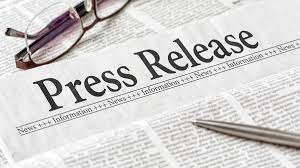Even if you’re using a wide variety of channels to promote your business—from email and social media to paid adverts and in-person events—even a single mention in the media can bring in a flood of new consumers and help you scale your operation to the next level. The ability to write a press release for a book, product, nonprofit, or event is a valuable talent for any marketer. Today, more than ever, it’s important to issue a press release. The vast majority of Americans (82%) said they regularly or occasionally use their smartphones to access the news. Using press releases to establish credibility in the eyes of the media might pave the way to new clientele.
The purpose of a press release needs to be understood before we can go into depth about how to write one.
What Is a Press Release?
A press release is an official statement sent by a company to the press and other interested parties. What is variously known as a “press release,” “press statement,” “news release,” and “media release” is essentially the same thing.
The headline should include a verb in it, and the first paragraph should explain the “who,” “what,” “why,” and “where.” The press release must also use clear language and include a quote.
Also, the average length of a news release is one to two pages. In the end, businesses want to provide the media with enough material for their own articles about whatever it is they’re announcing in the release.
Keep in mind that your press release will be available to the public and therefore your stakeholders and clients. So, instead of viewing a press release as a means to gain publicity in the form of news coverage, view it as promotional content with real value.
Types of Press Releases
Putting out a press release is often considered nothing more than a publicity stunt. However, several varieties of press releases exist, each with its own standards and conventions.
#1. Breaking News
This is the most typical kind of news announcement. It is in the interest of every news organization to break a story as soon as possible. News outlets will cover a wide variety of topics, from COVID updates to Bitcoin, but it is the hook in your narrative that will get your press release read. These news announcements are typically one or two pages long and are distributed to the general public.
#2. Product Launches
A press release in the form of a product launch is an effective way to spread the news about the innovative products or services your company is now giving to its clientele.
Also, Specifications, cost, and availability are all important aspects that should be highlighted.
#3. Mergers and Acquisitions
A press release should be sent whenever there is significant organizational change, as this is an effective way to keep current and potential stakeholders abreast of the development and course of the business.
Include background on each company, specifics on the acquisition or merger, and statements from top executives when making an announcement of this nature.
#4. New Partnerships
A press release announcing a new alliance is a win-win marketing strategy, not unlike a merger or acquisition.
However, a well-executed announcement of this type will include a synopsis of the involved companies, an explanation of the partnership’s rationale and intended beneficiaries, and any other pertinent information for the public at large.
#5. Rebranding
Companies of all sizes face difficulties when attempting to rebrand. If a company suddenly changes its name or logo, it could cause some confusion among its clientele. Putting out a press release to let the world know about your company’s rebranding can make the changeover to the new identity smoother.
Make sure your news release regarding the rebranding includes the following.
- What the alterations are
- The driving force behind the shifts
- The repercussions for the clients you serve
- When the adjustments are made
- Leadership quotes
#6. Events
A Press release about an event can provide journalists with something timely and relevant to write about. They’re a wonderful tool for spreading the word about your function and drawing in additional people. Make sure to give specifics when you want to write a press release for an event. Make use of bullet points or a list to make the who, what, when, and where of your writing easy to digest.
What Are Five Rules When Writing a Press Release?
A skilled public relations executive’s primary responsibility is to collaborate with clients in the identification and development of story ideas that have the potential to attract the interest of editors, journalists, and, ultimately, the public. So how can you get your press releases seen in a journalist’s overflowing inbox?
While news releases tend to follow a formulaic format, the information contained within them might vary greatly. Writing an effective press release requires knowledge, perspective, and talent. Smart, interesting, and artistically written are the hallmarks of a job well done. Here are the 5 golden rules needed to write a press release.
- Create a compelling narrative.
- Use your opening paragraph wisely.
- Create a compelling headline and email subject line
- Include numbers and statistics to back up your claims.
- Quotes should be powerful and unforgettable.
Why Write a Press Release?
There are many alternative formats for articles, and the press release style has its own benefits for companies. Some of the most important reasons why you should write a press release are listed below.
- Get the attention of the public. A press release can be picked up by the media if it contains interesting information. Your company can gain exposure and access to new customers if your press release is picked up by other groups or published in the media.
- Gain exposure for your product or service. There is a lot of effort to be done when it comes to raising a company’s profile. A concise press release can increase exposure for your business and possibly spark interest in your product.
- Boost Your SEO. SEO, or search engine optimization, is something many companies and groups care about because it improves the visibility of a company’s website in SERPs. If the press release is concise and includes relevant keywords or is shared by other websites, it can boost search engine optimization.
- Influence how customers see your company. Spreading the word is crucial, but so is leaving a positive impression on those you meet along the way. To influence the public’s perception of your business, press releases are excellent platforms for showcasing your brand’s voice and personality. When combined with other tactics, like email marketing, it becomes much easier to control how your brand is seen.
Furthermore, you can also distribute your press releases through your website’s news or press section. This can help people recognize you as an authority in your subject. If a journalist visits your site and sees press releases, you’ll come across more professional and save the journalist time by having all the material they need in one place.
What Is the Format for a Press Release?
Here are some formats for a press release.
- At the top, you’ll see the contact details and the phrase “For Immediate Release.”
- Summarize the news using a catchy headline and an italicized subheading.
- Setting the hook for the news in the first sentence.
- Two or three paragraphs are needed to provide background and extra information.
- Lists of information and/or data.
- Below is a brief overview of the company.
- The release is complete when you see three-pound signs (###) at the very end.
Write your press release as though it were a piece for a news website so that journalists who might be interested in writing about it can do so easily.
Here are the foundational pieces of information that should be in every press release:
- The top left corner features your contact information.
- The term “for immediate release” appears in the top right corner.
- A catchy title that sums up the news in a few words
- Start the press release with a reference to your company’s location.
- Include a brief company bio at the end of the release.
If you wish to let the media know that the release is over, you can use “###” or some other symbol. When there was no new information, this kept busy reporters from having to wait or turn the page. But this custom is still widely practiced and appreciated.
The main point of your press release should now read:
- In the first paragraph, you should explain the nature of the announcement and provide background information about your company.
- A spokesman or official from the company should be quoted in the next two or three lines to explain the “why” behind the announcement.
- The final paragraph should serve as an “About Us” section in which you describe your business and the services it provides.
When Should You Write a Press Release?
When announcing a merger, a new product line, or the hiring of key personnel (such as executives or developers), a press release is the most efficient way to get the word out. You can also use it to boast about the recognition your business or its staff have achieved by displaying any relevant awards.
How to Write a Press Release
Knowing what to include in your press release will increase its effectiveness. If you stick to this outline, you should be able to craft a release that effectively conveys your narrative and attracts the attention of the media.
#1. Create a Catchy Headline
You’ve thought about your announcement and are ready to share it with your network and the people in your field.
The success of your press release depends on its headline, just as the success of your blog post depends on its title. Having only one line to work with can be intimidating, but with some careful word choice, you can create an attention-grabbing headline.
If you want your headline to grab attention, consider the following:
- Make use of verbs that imply motion.
- Provide details.
- Don’t go on and on.
Keep in mind that reporters receive dozens, if not hundreds, of releases every day, so take the time to develop a striking headline.
On the other side, consumers’ feeds are littered with stories on the latest events. That’s why you need a catchy title to get their attention.
#2. Inform the Press Why This Is Noteworthy
Give the readers of your press release a cause to care about the subject matter.
Use the inverted pyramid formula when crafting your press release for maximum effect. The most crucial details are presented first, followed by the less crucial ones.
Your release’s first paragraph should cover the who, what, and where, while the second should go into the why. Reporters don’t have time to comb through irrelevant details and personal anecdotes; they need the hard material that will help them sell your article to an editor or higher-up.
Also, the reader shouldn’t be presented with any fresh, significant information following these parts.
#3. Put Out an Alluring Quotes
The next step is to give your announcement some color by including a quotation that reporters can use to assist set the stage and paint a picture of how your news will affect the industry, client base, and environment you’ve described.
You should try to get quotes from people who have a vested interest in the outcome of your announcement, such as company executives, project managers, or those who will be directly affected.
By referencing relevant experts and thought leaders, you highlight the significance of your progress. Your story and the meat of your announcement should be shaped by the quotation you pick.
Don’t feel that you have to get input from all 25 people who were part of the acquisition by polling your office. Select an important spokesperson or two and center the remarks on their opinion.
#4. Give the Reader Some Context for the Topic at Hand
In this final paragraph, you should reiterate information that the reader should already know.
In this section, you can include supporting information, such as the unique approach your organization took to developing the project or announcement at hand. Or, if relevant, discuss the long-term effects of your declaration.
Newsjacking is another effective strategy for boosting the impact of your press release. A technique for making your press release more relevant to the needs of journalists and their readers.
#5. Condense the “Who” and “What” Into a One- Or Two-Sentence Summary
Reporters frequently complain on Twitter about poorly written press releases and pitches that fail to convey the nature of the company’s work or the significance of the announcement.
Include a link to your company’s website upfront and explain your services in simple terms.
If you’re citing data, provide a link to the source, and verify that each person mentioned in the release has a matching title and organization.
However, to ensure your own integrity in this matter, have a coworker read the release out of context and report back to you on its contents. If they can’t answer “who,” “what,” or “why,” then they need to go back to the drawing board.
#6. The Standard Closing Phrase
Put together a compelling yet brief boilerplate to round out your release. Describe your company’s mission and how its stakeholders distinguish it as a leader in its field. Include a way to get in touch with you. If a reporter can’t get in touch with the stakeholder or a representative of the stakeholder, the release won’t go very far.
Give a brief history of the company and an outline of what it does. Put your contact details in there. (Three ### symbols or “–30–” are often used at the end of a news release to indicate the end.)
Make sure your press release is free of typos and grammatical problems by giving it a second read-over. Before sending off your paper, try a free online grammar checker to ensure that it reads smoothly and effectively.
How to Write a Press Release for a Book
Public relations (PR) can be a useful instrument for increasing an author’s profile, but there is a proper and improper approach to obtaining it.
After finishing a book, many authors send out a press release in the hopes of gaining media attention and positive public relations. This is simply not so. The idea that news outlets must issue press releases is a relic of a bygone era.
This piece will show you the most up-to-date best practices for writing a book press release, but you may still utilize our book publicity tool to help you acquire PR.
In What Ways Might a Press Release Benefit Book Authors?
Sending out a press release to various media outlets and online discussion boards is a great way to get the word out about your new book and get people talking about it. A successful press release may result in requests for interviews, book reviews, speaking engagements, or website visits; it may also generate brief mentions in newspapers and magazines. It’s also a free promotional tool, so any self-publisher or independent author can use it to showcase their work.
While a press release is just one component of a comprehensive marketing strategy that also includes an author’s website, mailing lists, and social media networks, it is written to attract the attention of journalists, editors, bloggers, publishers, book reviewers, and other influential individuals who may not already be on your contact list. If you manage to get their attention, they may even assist you spread the information to more people. Also, read RELEASE MANAGER: Definition, Job Description, Salary & How to Become One.
Writing a press release for your book is a great way to let everyone know the exciting news, even if you’re already having dialogues with your readers and the creative community on social media.
When Would You Recommend Releasing a Book Press Release?
Typically, the day a book first goes on sale is also the day a press release is issued to announce the book’s release. If you want your press release to appear in the media or other publications, you should send it to them at least three to five days in advance. If the media outlet is huge, you should expect a longer turnaround time for publishing to accommodate the increased volume of requests that they are likely handling.
Even if it’s several weeks or months after the book’s initial publication date, you might want to time your press release to coincide with a noteworthy issue, launch event, or award ceremony that your book is associated with.
Here are steps on how to write a book press release.
#1. Find the Newsworthy Slant
Media organizations aren’t interested in buying your book; they’re interested in reaching their readers. A press release for your book does not serve as an outline or comprehensive summary of your work. Instead, it emphasizes the specific audience that will enjoy your book.
The goal is to provide news outlets with a concise “hook” or attention-grabbing headline. In addition, it is up to you to discover what that is.
#2. Draft Book Announcement Press Release
Formatting is crucial if you want media outlets to respond to your press release. They are not willing to put in significant effort to adapt it for wider distribution.
The following are the components of a good news release:
- Third-person writing. Your press release’s tone should be that of an objective news report, not an infomercial. The press release is the starting point for the article for the journalist. They won’t waste time rewriting work written from the “I” point of view.
- Headline for a Press Release. The bait is right here. Get the reader interested by finding a unique spin on the news. Maintain brevity and wit. Try to keep it under 20 words. Also, consider what kinds of headlines tend to pique your interest if you find yourself stuck. Remembering the inspiration behind your book’s title could also prove useful. In many ways, it’s the same as before.
- Subheader. Just this one statement expands my knowledge of your work considerably. The point here is to elaborate on your news slant. The subheading is the trailer if the headline is the teaser. Also, the title grabs the reader’s attention, while the subheader provides a more meaty justification for continuing to read.
- Dateline. Include the release date, your city, state, and country. Also, insert between brackets before the opening paragraph.
- Intro. In your press release, this is a crucial section. Make a bold proclamation right off the off. So, let’s cut to the chase. Daily, editors are inundated with dozens of press releases. Yours will stand out from the crowd if you provide the reader immediate incentive to keep reading.
#3. Publish the Announcement
You could theoretically distribute a press release to every single news organization.
That’s a bad idea. When time is of the essence, most people turn to a syndication service. When you pay a syndication service, they will send your press release to their extensive list of contacts in the media.
The audience for a syndication service is vast. Many of these lists include hundreds, if not thousands, of publications.
However, keep in mind that perspectives are different from reads. It is not certain that an editor or journalist will read a press release just because it has been sent to a publication.
This is why you need your press release to be unique if you want genuine interest.
Sending the press release straight to the media source to which you believe your book would be of most interest is an option. This may be, for example, a trade publication. You can modify it to emphasize the points that will appeal to the target publication.
How to Write a Press Release for a Nonprofit
The use of press releases is crucial for both large corporations and one-person operations in the nonprofit sector. Writing and distributing press releases is an efficient way for nonprofits to connect with the local press and spread news about their work.
A Nonprofit press release is a brief article published in the style of traditional news stories.
Timely information about your charity organization can be disseminated via press releases in the hopes that interested media will get in touch with you for an interview or other in-depth coverage. A one-page press release is a quick, reliable, and free way to get your organization’s news out to the public.
However, the appointment of a new executive or the launch of a new program are both examples of significant company news that would be suitable to report in a press release. Writing a press release is recommended if your nonprofit is hosting an important event or has won significant grant funds.
The recipients of your press releases will include journalists in newspapers, broadcast networks, online publications, and social media influencers. The press release may also be distributed to relevant community members, major funders, members of local government, and the general public.
Why Is Nonprofit Press Release Important?
When it comes to spreading the word about what they do, organizations can’t beat the priceless value of press releases as a no-cost marketing strategy. You can position yourself as a local authority on your topic and strengthen your contacts with media outlets by issuing a press release.
For important community updates, residents know to go to reputable media sites. By issuing a press release, your company will be linked to this reputable news source.
Sometimes local news sections of newspapers may run press releases, and radio DJs will read them on the air as a news item. In a tiny or understaffed newspaper, your press release may be rapidly approved for publishing without many modifications if it is effectively written.
That’s why it’s crucial to know how to write the perfect press release for your nonprofit. A well-formatted press release for a charitable organization makes it simple for the media outlet to report the story as intended.
The following are some potential benefits of having journalists print your press release:
- A journalist who has read your press release wants further information and contacts your company.
- A journalist learns about your organization and its goals for the first time, initiating a partnership with you and your non-profit.
- For free expense and coming from a reputable member of the community, a reporter will distribute your news release to their readers.
The following guidelines will set you on how to write an effective press release for your nonprofit. There is a slight learning curve at the outset, but once the basics are mastered, you’ll be well on your way to success.
#1. Compose an Engaging Opening Sentence
Nonprofits can use news writing basics to craft effective press releases. First, the lead, often known as the lede, of a press release needs to be compelling. A good lead should intrigue and hold the attention of the reader. Typically, a lead is a single sentence, but it can be two.
A good lead should incorporate as many of the “five W’s and an H” tale elements as possible. If you’re having trouble writing the lead, try thinking about the who, what, when, where, why, and how of the story. If at all possible, please write your responses to those questions in the nonprofit press release in a single phrase. This will convey the most important details quickly.
#2. Think Like Your Readers
The most effective way to write a press release for a nonprofit is to target the people who will care about their message. It’s tempting to want to reach as many people as possible, but doing so will likely result in wasted time and resources.
- Consider Your Influence. The potential impact of each given charitable organization needs to be carefully evaluated. Many large national NGOs, such as the American Cancer Society, blindly distribute press releases to any and all media sources. This may be more typical if you work for a large charity. However, many smaller charities will need to network with regional journalists and media sources.
- Pick your option. It’s vital to send the press release to the right people after you’ve tailored your message to them. While most nonprofits do keep a master list of media contacts, each individual press release should be sent only to the appropriate people. It’s tempting to blast everyone on your list with every press release. However, you will benefit in the long run if you target the right audience. If you bombard everyone with every press release, they might think they’re being spammed and unsubscribe from your emails.
#3. Stick to the Basics
When writing a press release, it can be tempting to go into great detail.
After all, it’s tough to keep quiet about an accomplishment you feel meritorious about. Maintain brevity and clarity when you write your press release, and make sure it backs up your main points in the first paragraph.
You may improve the chances that your readers will understand and remember your intended message and stay on topic by keeping your nonprofit press release short and to the point.
Paragraphs should average 30 to 35 words in length. The press release as a whole should not exceed one page.
Also, keep your readers in mind as you write. If the target audience is non-specialists, you may need to explain technical words and other jargon. The tone and vocabulary should be professional and similar to that of the journalists you’re pitching to.
#4. Make It Easy to Glance
The arrangement of your press release should be such that it can be quickly skimmed by a busy journalist. This allows a seasoned media professional to swiftly grasp your press release’s most important points.
Your press release could be more user-friendly with the addition of a few basic tools. Can you use a bulleted list to emphasize key points? Another option is to emphasize either the new program’s name or the whole amount of the grant you were awarded by using bold. The greatest information may be highlighted by following these easy formatting procedures.
Use these skimming tactics with caution, as you would any other method. Overuse of these methods can have an adverse effect. It can be difficult to understand a press release for a nonprofit if it has too many words in bold and bullet points.
#5. Supplement Your Account
There are several ways to write your nonprofit press release that “extra something.”
The success of a non-profit’s press release depends on the inclusion of meaningful quotes. Let your executives, employees, volunteers, or recipients be the focus of the news release. Press releases can benefit from having a human touch added through quotes, which can also serve as the release’s “summary” or main source of information.
Use the proper title or position when quoting someone in your nonprofit’s press release. The best quotations have succinct, direct sentences.
Use case studies and testimonials to bolster your narrative. Include a lot of numbers in your press release to back up your claim. A claim about a trend requires evidence. Adding numbers to your argument will make it more convincing.
In addition, pictures and movies are a nice extra treat.
#6. Keep Yourself Reachable
Sending out a press release increases the likelihood that a member of the media will follow up with you. The journalist can’t get in touch with you unless they can easily find and use your contact information.
Make sure the phone number, address, and URL on your letterhead are correct.
#7. Keep Your Contact List Up-To-Date
Examine your mailing list after you’ve created a press release that will interest journalists and their readers. Both reporters and representatives frequently come and depart. Always be in touch with your media outlets to ensure you have the most up-to-date contact details on hand.
The email monitoring services provided by a system used by nonprofits to communicate with their donors and constituents are a valuable resource. You should investigate why a press release email was returned if it was sent to the wrong person. To double-check that you entered the address correctly, you may also look it up in your email database.
How to Write a Press Release for an Event
A press release is a kind of written communication used by experts to disseminate newsworthy information to the public and the media. Press releases are useful tools for public relations professionals because they allow them to announce an event, notify the media of it, and solicit coverage. If you want to work in public relations or a related field, knowing how to write a press release for an event is a necessary skill.
Here are simple steps to write a press release for an event.
#1. Make a Playlist or a Video Library
The first step in writing a media release is selecting the media outlets and reporters you want to cover your story. Sports reporters, but not political or city hall reporters, might be on the media list for a story on a sports-related program announcement.
#2. Prepare a Press Release Format
An outline is a great place to start when writing a press release since it helps you remember to include the title, dateline, introduction paragraph, body copy, and any pertinent quotes. The US Press has specific criteria regarding the abbreviation of places and the capitalization of titles that must be agreed to.
#3. Draft a Statement for the Media
Emphasize the most important background information in the first paragraph, including the main characters, the setting, the time period, and the driving force behind the action. You might attract your audience to write about the press release by providing relevant data and statistics about the event.
#4. Think About Adding Some Pictures
Some news organizations may ask to use the images taken by the event photographer even if others want to take their own. Many professionals, when giving photos to reporters for use, add the photographer’s identity, the names and titles of individuals pictured, and captions when necessary.
#5. Embrace Cliches and a Contact Address
The boilerplate is the typical company information included in all released communication documents, such as the company’s founding date, history, or mission statement. However, this disclaimer can be placed after all other content but before any media contacts.
How to Write a Press Release for a Product
Writing a press release for a product can be nerve-wracking. They appear to be this massive, official, structured document that must adhere strictly to the conventional framework or risk being dismissed by the media as unprofessional.
Thank goodness, that is no longer the case. Now, more than ever before, PR professionals have the chance (and the obligation) to make their work shine and put their companies in the spotlight in innovative ways, thanks to the proliferation of channels via which communicators can reach their target audiences.
A press release announcing a brand-new product is one such occasion. To get the word out and the public pumped up about a new product line, video game, car, or pretty much anything else, a firm or business will want to produce a professional public relations campaign.
Here are simple steps to write a press release for a product.
- Attractive heading
- Specifications in great detail
- Amazing imagery
- In-house company terminology
- Contact information
Conclusion
In conclusion, a press release is a useful marketing tool for businesses, but it won’t get you any free publicity. Media, influencers, and bloggers will become more familiar with your business if you send out releases on a consistent schedule.
It’s always a good idea to keep your name and company in the minds of media outlets in case they’re looking for a source in your field and happen to recall you. You can establish yourself as an authority in your field by reporting on important developments.
Also, maintaining a public profile takes time and energy. Sharing press coverage on social media might help maintain interest in your project. Include a reference to recent media attention in the release’s generic language.
How to Write a Press Release FAQS
What Is a Good Press Release?
A good press release, such as one written in AP style, will have a title, a dateline, a press release body, and a boilerplate. It needs to go right to the point, appeal to the right people, and end with a call to action (CTA) and media contacts.
What Not to Write in a Press Release?
Hype, overblown claims, and advertising-like language have no place in a press release. Mistakes to avoid include failing to be newsworthy, having headlines that are uninspiring or boring, and writing in an improper format or style.
Similar Articles
- PR IN BUSINESS: Types, Functions and Benefits
- Public Relations Specialist: What They Do, Salary,& Becoming One
- User Acquisition: Strategies & How It Works (Detailed Guide)
- RELEASE MANAGEMENT: Meaning, Process, Duties, Salary, & Software
- HOW TO WRITE A MANIFESTO: The Ultimate Guide





